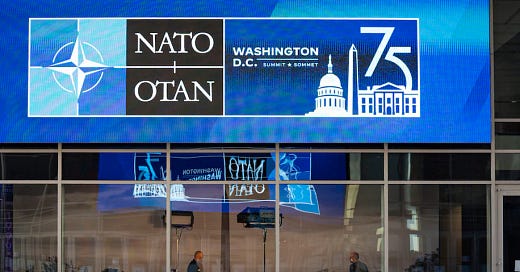NATO at 75: Celebration, Commitment and Caution Amidst Ukraine War
The atmosphere in Washington D.C. is far from celebratory, with the ongoing Ukraine conflict and concerns over President Biden's health casting a shadow over the proceedings.
The NATO 75th Anniversary Summit
This week, the North Atlantic Treaty Organization (NATO) celebrates its 75th anniversary with a significant summit hosted by President Biden in Washington, D.C., from July 9th to 11th. "Today, NATO is more powerful than ever—32 nations strong," President Biden declared during the opening session. As NATO members gather, the focus extends beyond celebrating historical achievements to addressing pressing geopolitical challenges, especially those related to Ukraine.
NATO’s Continued Support for Ukraine
Amid the ongoing conflict with Russia, NATO’s commitment to Ukraine remains strong yet cautious. The alliance has announced new initiatives to train and arm Ukrainian forces, reinforcing its continued partnership. However, the prospect of Ukraine's full membership in NATO is approached with caution. A primary concern is the complexities involved in integrating a nation that is actively engaged in conflict with Russia, a nuclear-armed state.
Additionally, the funding of Ukraine's war effort has seen significant developments. Notably, during the recent G7 summit in Rome, it was agreed that $300 billion in Russian assets frozen in European banks would be tapped to support Ukraine, a move spearheaded by the United States to bolster Ukraine financially in its struggle against Russian aggression.
Strategic Implications of Non-Membership
While NATO stops short of offering full membership, the alliance plans to strengthen Ukraine's military capabilities significantly. This includes transitioning some U.S. support activities to NATO control, aiming to provide a more structured support system for Ukraine. Although these measures fall short of full membership, they represent a significant deepening of ties and a commitment to Ukraine’s defense and sovereignty.
President Biden’s Health and Leadership
Concurrently, President Biden's health has been a topic of interest and concern. Amidst the intense activities of the summit, the administration has addressed inquiries about his capability to lead, emphasizing his ongoing commitment to both domestic and international challenges. Biden's leadership at this critical time underscores the U.S.'s dedication to maintaining a strong NATO alliance amidst internal and external pressures.
NATO— History of its Formation
After World War II, amidst the emerging geopolitical tensions that defined the early Cold War era, NATO was established in 1949 as a collective defense alliance aimed at deterring Soviet expansion in Europe. The formation of NATO was a direct response to the division of Europe by the "Iron Curtain," a term popularized by Winston Churchill to describe the boundary separating the Soviet-controlled countries of Eastern Europe from the West. As the Cold War intensified, the Soviet Union countered NATO's formation by creating the Warsaw Pact in 1955, aligning Eastern European countries against the NATO allies in a stark military standoff that would persist for decades.
NATO After Collapse of Soviet Union
The collapse of the Soviet Union in 1991 marked a significant turning point, leading to the disintegration of the Warsaw Pact. This pivotal moment opened the door for many former Eastern Bloc countries to seek membership in NATO as part of their transition towards democratic governance and integration into the Western political and security framework. Since then, NATO has undergone significant expansion, most recently with the addition of Finland and Sweden, strengthening the alliance's presence in Northern Europe.
Attack on One, Deemed to be Attack on All
A cornerstone of NATO's enduring relevance is Article 5, which asserts that an attack on one member is an attack on all, a principle invoked for the first time in response to the September 11, 2001 attacks in the United States. However, the issue of extending NATO membership to Ukraine remains contentious, as it involves complex strategic considerations given Ukraine's direct conflict with Russia, highlighting the delicate balance NATO must maintain in its eastern expansion efforts.
Looking Ahead: Challenges and Expectations
As NATO looks to the future, the alliance faces the dual challenge of evolving global threats and internal disagreements among its members about strategic expansions, like the inclusion of Ukraine. The summit is set to define the next phase of NATO's evolution, focusing on enhancing collaborative defense strategies and reaffirming commitments to current geopolitical challenges.
Conclusion: A Time of Reflection and Action
The 75th anniversary of NATO is not just a ceremonial occasion but a pivotal moment for strategic decision-making. As leaders from over 30 countries gather, they bring with them a collective resolve to adapt and strengthen the alliance in the face of modern challenges. While the summit offers Ukraine both support and a cautious pathway toward closer integration with Western defense mechanisms, the likelihood of admitting Ukraine into NATO during its conflict with Russia, a nuclear superpower, is slim without risking a major escalation, potentially to the level of a Third World War. This concern aligns with recent comments by Prime Minister Modi in Moscow, emphasizing the need to end the conflict through dialogue and address all underlying issues at the negotiation table.





